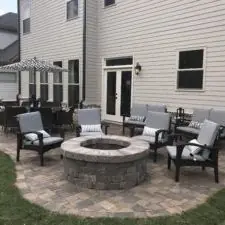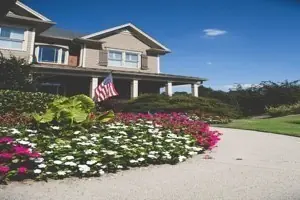Gardens have always been a sanctuary where we can connect with nature and unwind. As we move into 2025, garden designs are evolving to reflect our changing lifestyles and growing environmental awareness. Whether you have a sprawling yard or a cozy balcony, there are exciting trends that can transform your outdoor space into a modern oasis.
By embracing these exciting trends, you can create a garden that is both beautiful and functional, providing a perfect space to relax, entertain, and enjoy nature.
Sustainable and Eco-Friendly Gardens
Creating a sustainable and eco-friendly garden helps protect our environment while providing a beautiful space for us to enjoy. One way to achieve this is by using native plants that are well-suited to our local climate. Native plants require less water, fertilizer, and pesticides because they have adapted to the local conditions. They also provide a habitat for local wildlife, attracting birds, butterflies, and beneficial insects to our garden.
Another eco-friendly practice is composting. Composting kitchen scraps and yard waste produces rich, organic matter that can be used to nourish our plants. This reduces the need for chemical fertilizers and helps improve soil structure and water retention. Setting up a simple compost bin in a corner of the garden can make a big difference.
Water conservation is also a key aspect of sustainable gardening. Installing a rain barrel to collect rainwater can provide a free source of water for our garden. Mulching garden beds with organic materials like wood chips or straw helps retain moisture in the soil, reducing the need for frequent watering. Drip irrigation systems are another efficient way to use water, directing it right to the plants’ roots where it’s needed most.
By adopting these sustainable practices, we can create an eco-friendly garden that is both attractive and beneficial to the environment.
Multi-Functional Outdoor Spaces
Transforming our garden into a multi-functional outdoor space allows us to make the most of our area for various activities. One popular trend is the addition of outdoor kitchens and dining areas. These spaces provide a place to cook and enjoy meals in the fresh air. Including a grill, some counter space, and a dining table can turn our garden into a favorite spot for family dinners and gatherings with friends.
Creating play zones for children is another way to use our garden efficiently. Installing swings, sandboxes, or even a mini soccer field can provide endless entertainment for kids. These areas can be designed to blend seamlessly with the rest of the garden, ensuring that they add to the overall aesthetic appeal.
For those of us seeking tranquility, a quiet retreat can be designed within our garden. This space might include comfortable seating, a small water feature, or a hammock. Surrounded by plants and flowers, it can serve as a perfect spot to read, meditate, or simply relax.
Lastly, incorporating flexible furniture and movable planters can help us reconfigure the space based on our needs. This adaptability ensures that our garden remains a versatile area suitable for entertaining, relaxing, or playing.
By designing multi-functional outdoor spaces, we can create a garden that meets various needs and enhances our outdoor living experience.
Water Features and Dry Creek Beds
Incorporating water features and dry creek beds into our garden can greatly enhance its beauty and tranquility. Water features, such as fountains, ponds, and waterfalls, create a calming ambiance with the soothing sounds of flowing water. These features can become focal points in our garden, attracting the eye and adding movement and life.
Dry creek beds are a fantastic option for someone looking to manage rainwater runoff while adding a naturalistic element to the garden. These shallow trenches filled with river rocks and pebbles mimic the look of a dried-up stream. They help in directing excess water during heavy rains and prevent soil erosion. Additionally, we can plant native grasses and shrubs along the edges to soften the look and create a seamless transition into the rest of the garden.
Adding water plants to ponds or around water features can bring another layer of interest. Plants like water lilies, reeds, and lotus can thrive in and around water, providing habitat for fish and attracting beneficial insects like dragonflies. These plants can also help keep the water clean and balanced, making the maintenance easier.
By integrating water features and dry creek beds, we can create a dynamic garden space that is both aesthetically pleasing and functional.
Smart Garden Technology and Innovations
Smart garden technology is changing the way we care for our gardens, making it easier and more efficient to maintain a healthy landscape. One of the most popular innovations is automated irrigation systems. These systems can be programmed to water plants at optimal times, ensuring they get the right amount of water without wastage. Some advanced systems even have sensors that monitor soil moisture and adjust watering schedules accordingly.
Another useful tech innovation is plant sensors. These small devices can be placed in the soil to track conditions like moisture levels, temperature, and light exposure. Connected to a smartphone app, they provide real-time data and alerts, allowing us to address any issues promptly.
Garden planning apps are another tool that can help us design and manage our garden. These apps offer features like garden layout planning, plant care guides, and seasonal reminders. By using these tools, we can stay organized and ensure that our garden thrives throughout the year.
Robotic lawn mowers are a game-changer for lawn maintenance. These autonomous machines can be programmed to mow the lawn regularly, saving time and effort. They work efficiently, navigating around obstacles and providing a consistent, even cut.
By embracing smart garden technology, we can create a more efficient, productive, and enjoyable garden experience.
Conclusion
As we look forward to 2025, embracing new garden design trends can help us create outdoor spaces that are both beautiful and functional. From sustainable gardening practices that protect our environment to multi-functional spaces that suit our varied needs, there are plenty of ways to enhance our gardens. Adding water features and dry creek beds can introduce tranquility and charm, while smart garden technology simplifies maintenance and care.
Whether you are revamping an existing garden or starting from scratch, the key is to tailor these trends to your personal style and preferences. With careful planning and thoughtful execution, we can create a garden that reflects our love for nature and serves as a haven for relaxation and enjoyment.
If you are ready to transform your garden and need expert guidance, Sugar Hill Outdoors is here to help. Our team of luxury landscape architects can work with you to bring your vision to life. Contact us today to start planning your dream garden.





